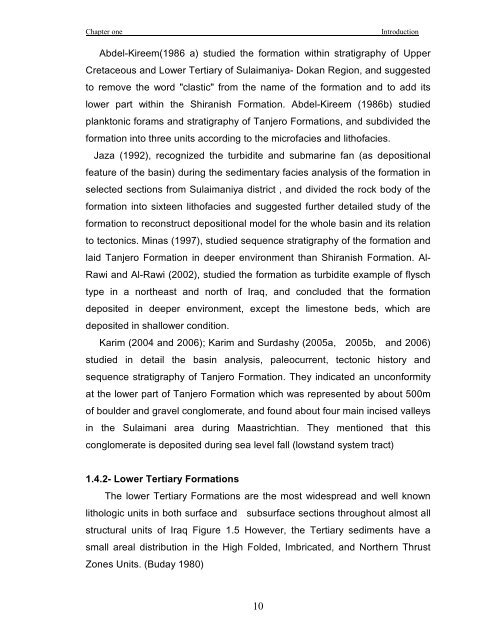biostratigraphy and paleoecology of cretaceous/tertiary boundary in ...
biostratigraphy and paleoecology of cretaceous/tertiary boundary in ...
biostratigraphy and paleoecology of cretaceous/tertiary boundary in ...
You also want an ePaper? Increase the reach of your titles
YUMPU automatically turns print PDFs into web optimized ePapers that Google loves.
Chapter one<br />
Introduction<br />
Abdel-Kireem(1986 a) studied the formation with<strong>in</strong> stratigraphy <strong>of</strong> Upper<br />
Cretaceous <strong>and</strong> Lower Tertiary <strong>of</strong> Sulaimaniya- Dokan Region, <strong>and</strong> suggested<br />
to remove the word "clastic" from the name <strong>of</strong> the formation <strong>and</strong> to add its<br />
lower part with<strong>in</strong> the Shiranish Formation. Abdel-Kireem (1986b) studied<br />
planktonic forams <strong>and</strong> stratigraphy <strong>of</strong> Tanjero Formations, <strong>and</strong> subdivided the<br />
formation <strong>in</strong>to three units accord<strong>in</strong>g to the micr<strong>of</strong>acies <strong>and</strong> lith<strong>of</strong>acies.<br />
Jaza (1992), recognized the turbidite <strong>and</strong> submar<strong>in</strong>e fan (as depositional<br />
feature <strong>of</strong> the bas<strong>in</strong>) dur<strong>in</strong>g the sedimentary facies analysis <strong>of</strong> the formation <strong>in</strong><br />
selected sections from Sulaimaniya district , <strong>and</strong> divided the rock body <strong>of</strong> the<br />
formation <strong>in</strong>to sixteen lith<strong>of</strong>acies <strong>and</strong> suggested further detailed study <strong>of</strong> the<br />
formation to reconstruct depositional model for the whole bas<strong>in</strong> <strong>and</strong> its relation<br />
to tectonics. M<strong>in</strong>as (1997), studied sequence stratigraphy <strong>of</strong> the formation <strong>and</strong><br />
laid Tanjero Formation <strong>in</strong> deeper environment than Shiranish Formation. Al-<br />
Rawi <strong>and</strong> Al-Rawi (2002), studied the formation as turbidite example <strong>of</strong> flysch<br />
type <strong>in</strong> a northeast <strong>and</strong> north <strong>of</strong> Iraq, <strong>and</strong> concluded that the formation<br />
deposited <strong>in</strong> deeper environment, except the limestone beds, which are<br />
deposited <strong>in</strong> shallower condition.<br />
Karim (2004 <strong>and</strong> 2006); Karim <strong>and</strong> Surdashy (2005a, 2005b, <strong>and</strong> 2006)<br />
studied <strong>in</strong> detail the bas<strong>in</strong> analysis, paleocurrent, tectonic history <strong>and</strong><br />
sequence stratigraphy <strong>of</strong> Tanjero Formation. They <strong>in</strong>dicated an unconformity<br />
at the lower part <strong>of</strong> Tanjero Formation which was represented by about 500m<br />
<strong>of</strong> boulder <strong>and</strong> gravel conglomerate, <strong>and</strong> found about four ma<strong>in</strong> <strong>in</strong>cised valleys<br />
<strong>in</strong> the Sulaimani area dur<strong>in</strong>g Maastrichtian. They mentioned that this<br />
conglomerate is deposited dur<strong>in</strong>g sea level fall (lowst<strong>and</strong> system tract)<br />
1.4.2- Lower Tertiary Formations<br />
The lower Tertiary Formations are the most widespread <strong>and</strong> well known<br />
lithologic units <strong>in</strong> both surface <strong>and</strong> subsurface sections throughout almost all<br />
structural units <strong>of</strong> Iraq Figure 1.5 However, the Tertiary sediments have a<br />
small areal distribution <strong>in</strong> the High Folded, Imbricated, <strong>and</strong> Northern Thrust<br />
Zones Units. (Buday 1980)<br />
10

















